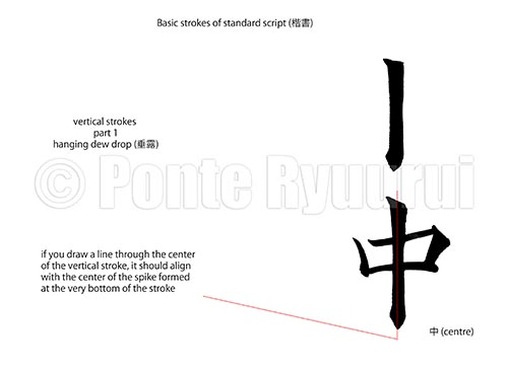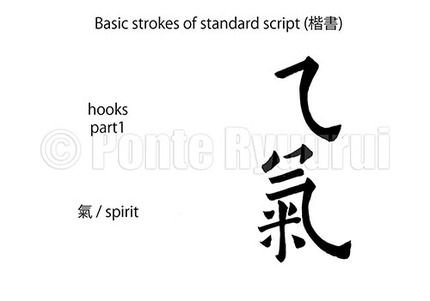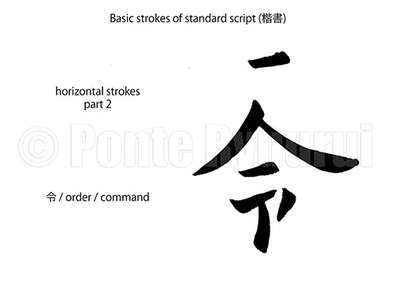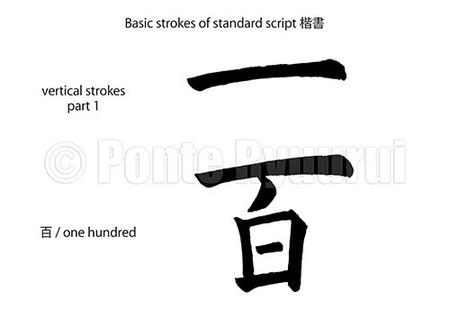 To read more on other types of strokes in standard script (楷書), please click here. Vertical strokes of standard script are among the most difficult brush strokes in Chinese calligraphy. They are complex (many micro brush movements) and require a lot of practice. The differences between the vertical strokes of Chinese calligraphy can be brought down to stroke endings. The foundation on which each of those strokes is built, is known as the "iron pole" (鉄柱), and it is one of the 8 core strokes of standard script (永字八法). The name "hanging dew drop" (垂露) comes from the appearance of the ending of this type of vertical stroke. It resembles a drop of dew hanging at the very end of a branch, or a twig. Chinese calligraphy and its theories are heavily related to nature. Many Chinese calligraphers based their calligraphy styles (書風) on natural phenomena. A falling rock, moves of a female sword dancer, geese turning their heads, etc. The difficulty of writing a hanging dew drop stroke, is in the challenge of presenting the kinetic energy of the water droplet, that is growing on the tip of a small branch. The video (below) shows only one style of writing the hanging dew drop stroke, which evolved during the Tang dynasty (唐朝, 618 - 907), and it is often found in the masterpieces of Ouyang Xun (歐陽詢, 557 – 641) .  To read more on standard script and vew other of my tutorials, please click here . There are many types of hooks in standard script (楷書), and they all have slightly different rules of writing. I will try to slowly cover them all, one by one. This particular hook is not an easy stroke to execute. It is complex and requires operating the brush at multiple angles. It starts with a slanting upwards vertical stroke. Then the brush is to be lifted (without loosing the contact with the paper surface). Next, the angle of writing is changed, the brush pressed down and proceeds to writing the curved line. This curved line varies in thickness, which effect is achieved by controlling the brush pressure. At the end of the curved line, the brush stops, angle is changed. The last movement is the sweep, which should be written very slowly. Below is a video with visual explanation. To see my other tutorials see the learning menu.  To read about other types of strokes in standard script, please click here. This type of horizontal stroke is slightly slanted upwards. Both ends should be parallel to each other. The stroke thickens towards the end. The key here is the brush operating technique (see the video for details) All strokes in standard script (楷書) should be written slowly and with care. Similarly to small seal script (篆書), even a small disproportion or distortion of balance will be immediately visible. In China standard script is often practiced on a gridded paper, for better understanding the proportions and angles of strokes, and their relations.  I will cover the history of the standard script (楷書) in a separate article, but for the sake of placing it on the timeline of the history of Chinese calligraphy, let me just say that its origins go back to 170 B.C, which fact was confirmed in 1972, when the unearthed bamboo slips in Hunan province (湖南) were covered in a script that displayed evident features of modern standard script. Standard script is one of the most demanding scripts in Chinese calligraphy, and also most likely the first one a new calligraphy student is about to study. There are 8 core strokes in standard script, and they are known as the 永字八法 (8 laws of the character 永). Each of those strokes has many variations. The details of the 永字八法 will be also covered in a separate article. There are many different approaches to standard script, and there are numerous classics written in various styles. Also, it is important to state that the Chinese calligraphy aesthetics and Japanese calligraphy esthetics differ. Consequently, although the rules of writing remain similar (or the same) the appearance of both may differ. Consequently, although the rules of writing remain similar (or the same) the appearance of both may vary. There are many different approaches to standard script, and there are numerous classics written in various styles. Alhough I study calligraphy in Japan, my teacher as well as the calligraphy organisations I belong to, put a very strong emphasis on Chinese classics. Therefore, my style is a blend of both types of calligraphy. Nevertheless, I decided to base my tutorials on the masterpieces of Ouyang Xun (歐陽詢, 557–641 C.E.), a brilliant Tang dynasty calligrapher, whose standard script was unmatched (although he was not the only genius of standard script in the history of China). His style may sometimes seem to be slightly over the top and "too elaborated", but the balance, character structure, and the surgical precision of strokes are simply mind blowing.
I remember I told my teacher once that I do not like a particular style of calligraphy (it was a Northern Wei standard script). He replied: "Studying only what you like is like taking a shortcut. Calligraphy is a journey. Those who are clever live by achieving an aim, and take the shortcut. Those who are wise, explore beyond their sight and become enlightened. " While studying standard script remember to: 1. write s l o w l y 2. learn the basic strokes 4. one stroke = one story 3. study different styles of standard script (do NOT copy me, copy the masterpieces) 4. never ever stop studying it, as standard script is the foundation of your skill with the brush |
Categories
All
AuthorPonte Ryuurui (品天龍涙) Archives
August 2020
|

 RSS Feed
RSS Feed
